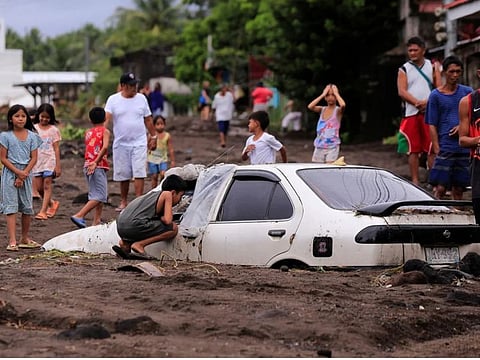Philippines: Typhoon Trami (Kristine) devastates Luzon, claims 24 lives
Storm causes significant damage to infrastructure, such as roads, bridges, power lines

Manila: Tropical storm Trami (locally known as Kristine), the 11th typhoon to hit the country this year, has ravaged the northern Philippines on Thursday, after inundating southern Luzon, leaving at least 24 fatalities primarily due to landslides, drowing, and debris.
The Bicol region, a wide area comprising six provinces south of Manila, was hardest hit. Residents have also reported flooding in certain areas of Manila, the capital. A Cavite resident also posted a video on X of a bus being swept away by a strong floodwaters on Thursday evening.
Death toll
The majority of the 24 fatalities were due to drowning in the severely affected Bicol region and neighbouring Quezon province.
In Caramoan town, where four people lost their lives. Many parts of the Manila-Bicol national highway remain impassable due to inundation.
The local Red Cross reported a storm surge in Pangasinan, about 200km north of Manila.
The storm caused significant damage to infrastructure, such as roads and power lines, and destroyed agricultural lands, impacting both crops and livestock.
Relief efforts are underway, with government agencies distributing food, water, and shelter to displaced families.
Officials expect the death toll to rise as more reports come in from areas cut off by flooding, landslides, and fallen trees.
As of 4am on Thursday, parts of Manila — Sto. Domingo Street, Araneta Ave, in Quezon City — have been water logged due to heavy rains brought by Trami/Kristine, as per local TV channel GMA News.
Villages trapped
Widespread flooding and landslides swept away vehicles and forced authorities to mobilise motorboats to rescue stranded villagers, some of whom were trapped on rooftops.
The government ordered schools and offices closed—except for essential disaster response services—for a second consecutive day across the entire main island of Luzon, following the overnight landfall of Trami in Isabela province.
A heavy rainfall alert with associated hazards (flooding, landslides) is up in Calabarzon (Cavite, Batangas, Laguna, Rizal, Quezon) and the national capital region (where Manila is) as well as Bulacan, Tarlac, Bataan, Zambales, and Pangasinan.
Trami was moving over Aguinaldo town in Ifugao province early Thursday, bringing sustained winds of 95 kph (59 mph) and gusts of up to 160 kph (99 mph).
It was expected to continue westward into the South China Sea later in the day, according to weather forecasters.
Damage to infrastructure
Rescue operations are ongoing, with the Philippine Coast Guard playing a critical role in reaching stranded communities.
Officials urge vigilance and cooperation from the public, as international support will be essential for recovery.
Ships grounded, thousands stranded
More than 8,700 passengers are stranded across the Philippines as Trami forced the closure of 126 ports.
The Philippine Coast Guard (PCG) reported the grounding of 142 vessels and thousands of delayed cargo shipments, compounding economic disruptions.
Authorities are prioritising stranded passengers’ welfare by ensuring access to food and water, though the timeline for resuming port operations remains uncertain.
Threat to Luzon
Although Trami is gradually weakening as it crosses the Cordillera Administrative Region (CAR), it continues to pose a danger.
Several provinces remain under Tropical Cyclone Wind Signal No. 3, and authorities advise residents to remain indoors and stay alert to hazards such as landslides and flooding.
The storm is expected to exit the Philippine Area of Responsibility by Friday (October 25).
Sign up for the Daily Briefing
Get the latest news and updates straight to your inbox



